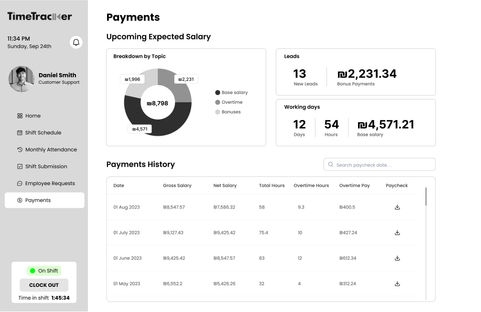As part of a course on Complex Systems, my team and I were tasked with designing a white-label EMS system.
We focused on the employee interface, detailing primary and secondary functions such as work schedules, shift submissions, leave requests, upcoming salary and more.
Scope: Complex Systems course
Role: UX Research, UI Design, UX writing
Tools: Figma, Illustrator

Problem Statement
-
Inefficient Work Hour Management - Existing systems are inflexible and not user-friendly, causing frustration and inefficiency.
-
Heavy Administrative Burden - Manual processes for managing work hours and payroll increase staff workload.
KPIs
Administrative Efficiency
Track the reduction in
hours spent on manual administrative tasks.
Employee Satisfaction
Percentage of employees who report satisfaction with the system’s usability and features.
Error Reduction Rate
Monitor the decrease in work hour logging, shift scheduling, and payroll processing errors.
Competitive Analysis
We identified three primary competitors and conducted evaluations of their systems. Additionally, we surveyed users who use these systems to gather feedback on key functionalities, drawbacks, and user satisfaction.

Key Findings
-
Calendar Integration - Systems that had updated holiday and salary increase information in their calendars achieved better user engagement.
-
Shift Scheduling - Binary shift submission (can/can't) led to more complaints compared to systems offering a "prefer not" option.
-
Flexibility - Systems allowing direct editing of work hours without manager intervention showed higher satisfaction.
Objectives & Goals
E-commerce Website
-
For seamless online purchasing without direct seller interaction
-
Secure payment gateway integration
Management Dashboard
-
To empower the client with autonomy in website management
-
Allows viewing and managing stock and orders, as well as editing information on the website
Interview Questions
Personal Details and Work Role
-
Age, gender, education
-
Job description
Platform Usage and Familiarity
-
User familiarity
-
Frequency of use
Tasks and Operations
-
Actions performed within the system
User Experience and Satisfaction
-
Feedback and ratings
-
Usability and satisfaction levels
Conclusions & Pain Points
Editing Work Hours
Enable employees to easily edit their work hours directly without additional approvals.
Vacation and Sick Leave Requests
Allow online submission of vacation and sick leave requests, providing clear records of available days for each employee.
Team Shift Visibility
Add the ability to view other team members' shift schedules to enhance coordination and communication.
Improved Reminders and Updates
Enhance notifications for shift starts and critical reports, ensuring timely and convenient delivery to employees.
Role Analysis
General employee
-
Role Level - Mid-to-entry-level position under direct supervision of higher managers,
errors primarily impact individual pay rather than others. -
System Competency - Basic digital proficiency and adaptability to new systems.
-
Required Skills & Knowledge - Essential knowledge of company operations and labor laws regarding work hours.
-
Role Related Goals - Varied per employee, key responsibility is accurate time reporting, crucial for payroll accuracy.
-
Task Analysis - Tasks according to role, hour reporting, communication with various entities, adherence to company policies.
-
Tools - Time management system, role-relevant equipment, chat system, calendar and meetings, payroll deductions.
Task Analysis
5=High, 0=Low
We identified and prioritized key tasks in employee management systems based on importance, frequency, and difficulty, using average scores to guide system accessibility definitions.

Information Architecture

User Flow
Log-in & Time Entry
Shift Submission
Design Solutions
1. Preventing User Errors in Time Clocking
Working memory is limited, especially during repetitive tasks, leading to forgotten actions. To prevent errors in clocking hours, the usability heuristic "status visibility" was applied.
The system informs the user of their status regardless of the page they are on.

2. Correcting System Errors
Mistakes happen, and not being able to fix them leads to frustration and avoidance. By implementing the usability heuristic "user control and freedom", we allow users to undo actions, correct errors, and edit information, promoting engagement and trust.

3. Increasing User Engagement and Completing Tasks
Submitting shifts is frequent and time-consuming. Users may struggle with the submission form or meeting quotas. We used gamification to boost engagement, turning the screen into a game board with immediate feedback and "points" for each shift, helping the employee meet the quota.

Full Wireframe Prototype

Wireframe Screens

Design System
.jpg)









.jpg)
.jpg)
.jpg)